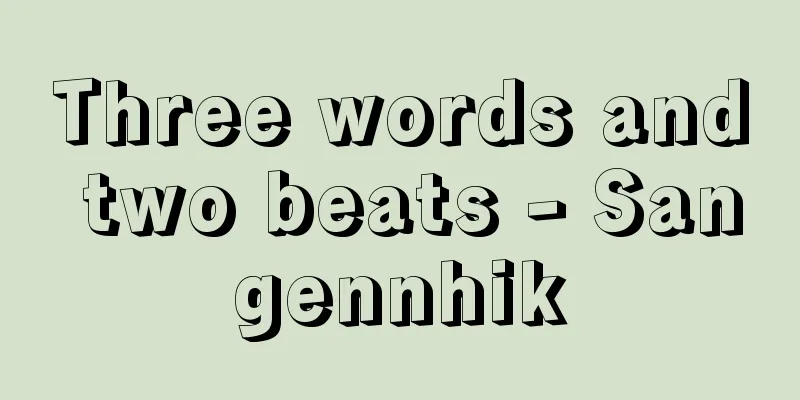Three words and two beats - Sangennhik

|
A collective term for "Novels of Ancient and Modern Times" (published in 1621?, later renamed "Words to Mention the World"), "Warning the World" (1624), and "Ever-Warning Words" (1627), all edited by Feng Menglong, as well as "Pai An Jinzhongqi" (1628) and "Er Jing An Jinzhongqi" (1632) by Ling Mianchu. During the Jiajing period of the Ming dynasty (1522-67), Hong Xuan published the texts (huaben) of novels (a type of lecture) that had been told by lecturers since the Song dynasty as "Sixty Family Novels." Feng and Ling then edited and published these works, adding later wahons and their own creations. Each work contains 40 pieces, but "Er Jie Bao An Jingqi" contains one play, and one of those pieces overlaps with "Bao An Jingqi," so the total number of pieces is 198. Thanks to the "three words, two beats," it is possible to see most of the wahon that existed in the late Ming dynasty, but the older works were also altered by Feng and Ling, so they cannot be considered as Song or Yuan dynasty playbooks as they are. It is also known from "Uso Kichinshu" and "Qingping Shandang Huabon," which are part of "Sixty Tales of Novels," "Four Novels by Kumaryuho," published around the Wanli period, and popular books of the time, that some stories were not suitable for engraving. "San Yan Ni Ba" fell out of use in China when "Kinko Kikan," a collection of 40 stories selected from the collection, was published. However, about 100 years after its publication, it was imported to Japan, where it was later published as "Shosetsu San Yan," which added kunten to some of the stories. This had a great influence on Edo period yomihon writers such as Tsuga Teisho and Ueda Akinari, and its rediscovery in the Meiji period greatly advanced research into storybooks. [Hidetaka Otsuka] "Matsueda Shigeo et al., Translated "Selections of Popular Novels from the Song, Yuan, and Ming Dynasties" (included in "Chinese Classical Literature Series 25", 1970, Heibonsha)" "Karashima Takeshi, Translated "Complete Translation of Chinese Literature Series 10-14, Everlasting Words of the Awakening World 1-5" (1958, Oriental Culture Association)" Source: Shogakukan Encyclopedia Nipponica About Encyclopedia Nipponica Information | Legend |
|
馮夢龍(ふうぼうりゅう)によって編集された『古今小説(ここんしょうせつ)』(1621?刊。のち『喩世明言(ゆせいめいげん)』と改題)、『警世通言(けいせいつうげん)』(1624)、『醒世恒言(せいせいこうげん)』(1627)、および凌濛初(りょうもうしょ)の『拍案驚奇(はくあんきょうき)』(1628)、『二刻拍案驚奇』(1632)の総称。明(みん)の嘉靖(かせい)年間(1522~67)に洪楩(こうべん)が、宋(そう)代以降、講釈師によって語られてきた小説(講釈の一種)のテキスト(話本(わほん))を『六十家小説』として刊行したのを受け、馮・凌2氏がこれ以降の話本や自己の創作をも加えて編集刊行したもの。各40編よりなるが、『二刻拍案驚奇』が戯曲を1編収め、かつその1編が『拍案驚奇』と重複するため総計198編からなる。「三言二拍」により、明末に存在していた話本のほとんどは目にしうるわけであるが、旧作も馮・凌2氏による改変を受けており、これをそのまま宋・元(げん)の話本とみなすことはできない。また刻するにふさわしくないと判断された話本が収められなかったことも、『六十家小説』の一部である『雨窓欹枕集(うそうきちんしゅう)』『清平山堂話本』、万暦ごろに刊行された『熊竜峯(ゆうりゅうほう)四種小説』および当時の通俗類書から知られる。「三言二拍」はその後このなかから40編を選んだ『今古奇観(きんこきかん)』が刊行されるに及び、中国では廃れるに至った。しかしその刊行よりおよそ100年を経て相次いで輸入された日本では、その一部に訓点を施した『小説三言』も刊行され、都賀庭鐘(つがていしょう)、上田秋成(あきなり)ら江戸時代の読本(よみほん)作家に多大な影響を及ぼすとともに、また明治に入って再発見されたその刊本は話本研究を大いに進展させた。 [大塚秀高] 『松枝茂夫他訳『宋・元・明通俗小説選』(『中国古典文学大系25』所収・1970・平凡社)』▽『辛島驍訳『全訳中国文学大系10~14 醒世恒言1~5』(1958・東洋文化協会)』 出典 小学館 日本大百科全書(ニッポニカ)日本大百科全書(ニッポニカ)について 情報 | 凡例 |
>>: Three Tenement Houses - Sangenagaya
Recommend
Kanamori Tsurin
Protestant theologian. Congregational pastor. He ...
"Study on the structure of the Ainu language" - Research on the structure of the Ainu language
…A full-scale dictionary is the Ainu-Russian Dict...
Achromycin - Achromycin
A brand name for the antibiotic tetracycline. Sour...
Pteroclidae
…Any of the birds in the family Pteroclidae (colu...
Village register - Goson takacho
In the Edo period, this was a ledger in which feud...
School Kendo
...The unification of styles, which was essential...
Sorolla (English spelling) Joaquín Sorolla y Bastida
1863‐1923 Spanish painter. Born in Valencia. After...
International Congress of Orientalists
… For example, the School of Oriental Studies at ...
Liquid line corrosion
…Fretting corrosion: Damage to metals caused by m...
Phenol - phenol
Compounds in which a hydroxyl group is bonded to ...
Yakuza movie - Yakuza movie
It is a general term for films with a yakuza as th...
Breitenfeld
…Instead of the volunteers used up until then, th...
Career group - Cariagumi
Career civil servants are lifelong civil servants ...
Capuchin Order (English: Ordo Fratrum Minorum Capuccinorum, Latin)
It is one of the three independent sects of the F...
Gonium
…They grow in rice fields, ponds, lakes, and othe...









